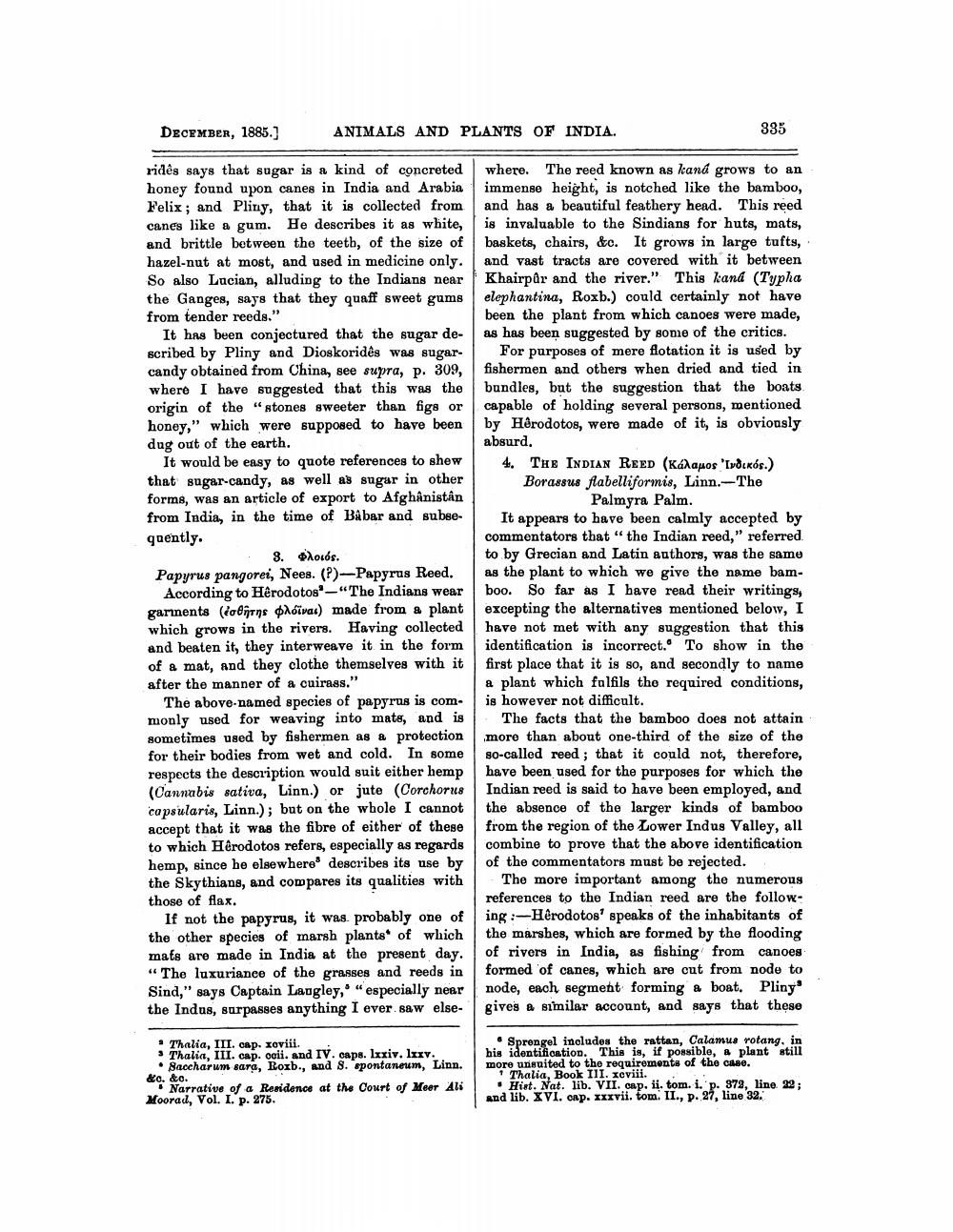________________
DECEMBER, 1885.)
ANIMALS AND PLANTS OF INDIA.
335
rides says that sugar is a kind of concreted where. The reed known as kand grows to an honey found upon canes in India and Arabia | immense height, is notched like the bamboo, Felix; and Pliny, that it is collected from and has a beautiful feathery head. This reed canes like a gum. He describes it as white, is invaluable to the Sindians for huts, mats, and brittle between the teeth, of the size of baskets, chairs, &c. It grows in large tufts, hazel-nut at most, and used in medicine only. and vast tracts are covered with it between So also Lucian, alluding to the Indians near Khairpar and the river." This kand (Typha the Ganges, says that they quaff sweet gums elephantina, Roxb.) could certainly not have from tender reeds."
been the plant from which canoes were made, It has been conjectured that the sugar de- as has been suggested by some of the critics. scribed by Pliny and Dioskorides was sugar- For purposes of mere flotation it is used by candy obtained from China, see supra, p. 309, fishermen and others when dried and tied in where I have suggested that this was the bundles, but the suggestion that the boats origin of the "stones sweeter than fige or capable of holding several persons, mentioned honey," which were supposed to have been by Hôrodotos, were made of it, is obviously dug out of the earth.
absurd. It would be easy to quote references to shew 4. THE INDIAN REED (Kalapos 'Ivdekós.) that sugar-candy, as well as sugar in other
Borassus flabelliformis, Linn.- The forms, was an article of export to Afghanistan
Palmyra Palm. from India, in the time of Babar and subse- It appears to have been calmly accepted by quently.
commentators that “the Indian reed," referred 3. Photos.
to by Grecian and Latin authors, was the same Papyrus pangorei, Nees. (?)-Papyrus Reed. as the plant to which we give the name bam
According to Hêrodotos'-"The Indians wear boo. So far as I have read their writings, garinents (iairns privat) made from a plant excepting the alternatives mentioned below, I which grows in the rivers. Having collected have not met with any suggestion that this and beaten it, they interweave it in the form identification is incorrect. To show in the of a mat, and they clothe themselves with it first place that it is so, and secondly to name after the manner of a cuirass."
a plant which falfils the required conditions, The above-named species of papyrus is com- is however not difficult. monly used for weaving into mate, and is The facts that the bamboo does not attain sometimes used by fishermen as a protection more than about one-third of the size of the for their bodies from wet and cold. In some so-called reed; that it could not, therefore, respects the description would suit either hemp have been used for the purposes for which the (Cannabis sativa, Linn.) or jute (Corchorus Indian reed is said to have been employed, and capsularis, Linn.); but on the whole I cannot the absence of the larger kinds of bamboo accept that it was the fibre of either of these from the region of the Lower Indus Valley, all to which Herodotos refers, especially as regards combine to prove that the above identification hemp, since be elsewhere describes its use by of the commentators must be rejected. the Skythians, and compares its qualities with The more important among the numerous those of flax.
references to the Indian reed are the followIf not the papyrus, it was probably one of ing:-Hérodotos' speaks of the inhabitants of the other species of marsh plants of which the marshes, which are formed by the flooding mats are made in India at the present day. of rivers in India, as fishing from canoes “The luxuriance of the grasses and reeds in formed of canes, which are cut from node to Sind," says Captain Langley, "especially near node, each segment forming a boat. Pliny' the Indus, surpasses anything I ever saw else- gives a similar account, and says that these
• Thalia, III. cap. zoviii. * Thalia, III. cap. ocii. and IV. caps. lxxiv. lxxv.
• Saccharum sara, Roxb., and 8. spontaneum, Linn. &c. &c.
Narrative of a Residence at the Court of Meer Ali Moorad, Vol. I. p. 275.
• Sprengel includes the rattan, Calamus rotang, in his identification. This is, if possible, a plant still more unsuited to the requirements of the case. + Thalia, Book III. xeviii.
Hist. Nat. lib. VII. cap. ii. tom. i. p. 372, line 22; and lib. XVI. cap. IIxvii. tom. II., p. 27, line 32




